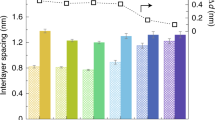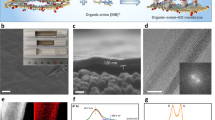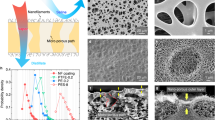Abstract
Membrane desalination is an emerging technology that shows promise for producing freshwater from saline waters. However, most membranes are challenged by low freshwater flux, impacting the water productivity, energy efficiency and membrane usage. Here we present the submicrometre-thick and nanopore-structured graphdiyne membranes on porous Cu hollow fibres. We accomplish nearly perfect NaCl rejections (>99.9%) and ultrahigh water permeabilities reaching ~700 l m−2 h−1, which are approximately 1–3 orders of magnitude higher than those of commercial polymeric membranes, in vacuum membrane distillation of a 3.5 wt% NaCl solution. Membrane stability is demonstrated by feeding hypersaline waters, real seawater and pollutant-containing waters. The resultant interfacial and microstructural properties of the membranes combine the interfacial ion sieving effect with vapour-transport capability to enable complete salt exclusion and accelerate the water flux. Experimental and theoretical studies have revealed that interfacial transport between graphdiyne interlayers increases the water flux by orders of magnitude relative to transport through intralayer pores.
This is a preview of subscription content, access via your institution
Access options
Subscribe to this journal
Receive 12 digital issues and online access to articles
$99.00 per year
only $8.25 per issue
Buy this article
- Purchase on Springer Link
- Instant access to full article PDF
Prices may be subject to local taxes which are calculated during checkout



Similar content being viewed by others
Data availability
The data supporting the findings in this study are available within the Article and Supplementary Information. Source data are provided with this paper.
References
Elimelech, M. & Phillip, W. A. The future of seawater desalination: energy, technology, and the environment. Science 333, 712–717 (2011).
Deshmukh, A. et al. Membrane distillation at the water-energy nexus: limits, opportunities, and challenges. Energy Environ. Sci. 11, 1177–1196 (2018).
Zhang, M. et al. Engineering a nanocomposite interlayer for a novel ceramic-based forward osmosis membrane with enhanced performance. Environ. Sci. Technol. 54, 7715–7724 (2020).
Gong, D. et al. Interfacial ions sieving for ultrafast and complete desalination through 2D nanochannel defined graphene composite membranes. ACS Nano 15, 9871–9881 (2021).
Lu, X. & Elimelech, M. Fabrication of desalination membranes by interfacial polymerization: history, current efforts, and future directions. Chem. Soc. Rev. 50, 6290–6307 (2021).
Sun, C. et al. Superhydrophobic carbon nanotube network membranes for membrane distillation: high-throughput performance and transport mechanism. Environ. Sci. Technol. 56, 5775–5785 (2022).
Ghaffour, N., Missimer, T. M. & Amy, G. L. Technical review and evaluation of the economics of water desalination: current and future challenges for better water supply sustainability. Desalination 309, 197–207 (2013).
Chen, W. et al. High-flux water desalination with interfacial salt sieving effect in nanoporous carbon composite membranes. Nat. Nanotechnol. 13, 345–350 (2018).
Holt, J. K. et al. Fast mass transport through sub-2-nanometer carbon nanotubes. Science 312, 1034–1037 (2006).
Werber, J. R., Osuji, C. O. & Elimelech, M. Materials for next-generation desalination and water purification membranes. Nat. Rev. Mater. 1, 16018 (2016).
Dong, Y. et al. Stable superhydrophobic ceramic-based carbon nanotube composite desalination membranes. Nano Lett. 18, 5514–5521 (2018).
Joshi, R. K. et al. Precise and ultrafast molecular sieving through graphene oxide membranes. Science 343, 752–754 (2014).
Chen, L. et al. Ion sieving in graphene oxide membranes via cationic control of interlayer spacing. Nature 550, 380–383 (2017).
Surwade, S. P. et al. Water desalination using nanoporous single-layer graphene. Nat. Nanotechnol. 10, 459–464 (2015).
Cohen-Tanugi, D., Lin, L. C. & Grossman, J. C. Multilayer nanoporous graphene membranes for water desalination. Nano Lett. 16, 1027–1033 (2016).
Yuan, B. et al. Cross-linked graphene oxide framework membranes with robust nano-channels for enhanced sieving ability. Environ. Sci. Technol. 54, 15442–15453 (2020).
Yang, J. et al. Self-assembly of thiourea-crosslinked graphene oxide framework membranes toward separation of small molecules. Adv. Mater. 30, e1705775 (2018).
Jia, Z. et al. Synthesis and properties of 2D carbon-graphdiyne. Acc. Chem. Res. 50, 2470–2478 (2017).
Gao, X. et al. Direct synthesis of graphdiyne nanowalls on arbitrary substrates and its application for photoelectrochemical water splitting cell. Adv. Mater. 29, 1605308 (2017).
Kou, J. et al. Water permeation through single-layer graphyne membrane. J. Chem. Phys. 139, 064705 (2013).
Qiu, H., Xue, M., Shen, C., Zhang, Z. & Guo, W. Graphynes for water desalination and gas separation. Adv. Mater. 31, e1803772 (2019).
Raju, M., Govindaraju, P. B., van Duin, A. C. T. & Ihme, M. Atomistic and continuum scale modeling of functionalized graphyne membranes for water desalination. Nanoscale 10, 3969–3980 (2018).
Zhou, J. et al. Synthesis of graphdiyne nanowalls using acetylenic coupling reaction. J. Am. Chem. Soc. 137, 7596–7599 (2015).
Yasuda, H. & Tsai, J. Pore size of microporous polymer membranes. J. Appl. Polym. Sci. 18, 805–819 (1974).
Li, Y., Xu, L., Liu, H. & Li, Y. Graphdiyne and graphyne: from theoretical predictions to practical construction. Chem. Soc. Rev. 43, 2572–2586 (2014).
Gao, X. et al. Robust superhydrophobic foam: a graphdiyne-based hierarchical architecture for oil/water separation. Adv. Mater. 28, 168–173 (2016).
Wang, S. S. et al. Superlyophilicity-facilitated synthesis reaction at the microscale: ordered graphdiyne stripe arrays. Small 13, 1602265 (2017).
Kan, X. et al. Confined interfacial synthesis of highly crystalline and ultrathin graphdiyne films and their applications for N2 fixation. Chemistry 26, 7801–7807 (2020).
Bao, H. H., Wang, L., Li, C. & Luoo, J. Structural characterization and identification of graphdiyne and graphdiyne-based materials. ACS Appl. Mater. Interf. 11, 2717–2729 (2019).
Zuo, Z. et al. A facile approach for graphdiyne preparation under atmosphere for an advanced battery anode. Chem. Commun. 53, 8074–8077 (2017).
Lee, J., Laoui, T. & Karnik, R. Nanofluidic transport governed by the liquid/vapour interface. Nat. Nanotechnol. 9, 317–323 (2014).
Zou, L., Zhang, X., Gusnawan, P., Zhang, G. & Yu, J. Crosslinked PVDF based hydrophilic-hydrophobic dual-layer hollow fiber membranes for direct contact membrane distillation desalination: from the seawater to oilfield produced water. J. Membrane Sci. 619, 118802 (2021).
Li, H. et al. Stable Zr-based metal-organic framework nanoporous membrane for efficient desalination of hypersaline water. Environ. Sci. Technol. 55, 14917–14927 (2021).
Zheng, L. B. et al. Preparation of PVDF-CTFE hydrophobic membranes for MD application: effect of LiCl-based mixed additives. J. Membrane Sci. 506, 71–85 (2016).
Ang, E. Y. M. et al. A review on low dimensional carbon desalination and gas separation membrane designs. J. Membrane Sci. 598, 117785 (2020).
Cao, Z. et al. Ultrathin ZSM-5 zeolite nanosheet laminated membrane for high-flux desalination of concentrated brines. Sci. Adv. 4, eaau8634 (2018).
Zhao, S. et al. Hydrophilicity gradient in covalent organic frameworks for membrane distillation. Nat. Mater. 20, 1551–1558 (2021).
Lu, D. et al. An ultrahigh-flux nanoporous graphene membrane for sustainable seawater desalination using low-grade heat. Adv. Mater. 34, e2109718 (2022).
Si, Y. et al. Flexible superhydrophobic metal-based carbon nanotube membrane for electrochemically enhanced water treatment. Environ. Sci. Technol. 54, 9074–9082 (2020).
Sun, L. et al. Graphdiyne: a two-dimensional thermoelectric material with high figure of merit. Carbon 90, 255–259 (2015).
Li, J. F., Guan, Y. S., Cheng, F. Q. & Liu, Y. Treatment of high salinity brines by direct contact membrane distillation: effect of membrane characteristics and salinity. Chemosphere 140, 143–149 (2015).
Seo, D. H. et al. Anti-fouling graphene-based membranes for effective water desalination. Nat. Commun. 9, 683 (2018).
Li, X. et al. Electrospun superhydrophobic organic/inorganic composite nanofibrous membranes for membrane distillation. ACS Appl. Mater. Interf.7, 21919–21930 (2015).
Straub, A. P., Yip, N. Y., Lin, S. H., Lee, J. & Elimelech, M. Harvesting low-grade heat energy using thermo-osmotic vapour transport through nanoporous membranes. Nat. Energy 1, 1–6 (2016).
Wang, J. & Liu, X. Forward osmosis technology for water treatment: recent advances and future perspectives. J. Clean. Prod. 280, 124354 (2021).
Wang, L. et al. Fundamental transport mechanisms, fabrication and potential applications of nanoporous atomically thin membranes. Nat. Nanotechnol. 12, 509–522 (2017).
Shen, J. et al. Fast water transport and molecular sieving through ultrathin ordered conjugated-polymer-framework membranes. Nat. Mater. 21, 1183–1190 (2022).
Abraham, M. J. et al. GROMACS: high performance molecular simulations through multi-level parallelism from laptops to supercomputers. SoftwareX 1, 19–25 (2015).
Jorgensen, W. L., Maxwell, D. S. & Tirado-Rives, J. Development and testing of the OPLS all-atom force field on conformational energetics and properties of organic liquids. J. Am. Chem. Soc. 118, 11225–11236 (1996).
Essmann, U. et al. Smooth particle mesh Ewald method. J. Chem. Phys. 103, 8577–8593 (1995).
Acknowledgements
We acknowledge support from the National Natural Science Foundation of China (grant numbers 21878322, 22075309 (G.Z.), U1932123 (G.S.) and 12105166 (X.L.)), the Science and Technology Commission of Shanghai Municipality (grant numbers 19ZR1479200 and 22ZR1470100 (G.Z.)), the University of Chinese Academy of Sciences (grant number WIUCASQD2021014 (G.S.)) and the Biomaterials and Regenerative Medicine Institute Cooperative Research Project Shanghai Jiao Tong University School of Medicine (grant number 2022LHA09 (G.Z.)). We thank J. Yang (SARI) for sample characterizations, Z. Guo (ShanghaiTech) for providing real seawater and A. Goldbach (DICP) for helpful discussions.
Author information
Authors and Affiliations
Contributions
G. Z. conceived and designed the project. G. S. and G.Z. conceived and designed the simulations. H. C. performed the experiments of membrane preparation, characterization, and membrane separation. D. G. prepared the schematics. X. L. and G. S. carried out the theoretical calculations. G. Z., H. C., X. L., and G. S. prepared the original draft. G. Z. and G. S. wrote the final version of manuscript. C. Z. and H. C. prepared the porous copper hollow fibres. Y. P. contributed to discussion and draft editing. Y. S. participated in project administration. D. G., G. L., P. W., J. F., and Z. L. contributed to materials characterization and long-term stability tests. All authors approved the final version of the manuscript.
Corresponding authors
Ethics declarations
Competing interests
The authors declare no competing interests.
Peer review
Peer review information
Nature Water thanks Yingchao Dong, Zhiping Lai and the other, anonymous, reviewer(s) for their contribution to the peer review of this work.
Additional information
Publisher’s note Springer Nature remains neutral with regard to jurisdictional claims in published maps and institutional affiliations.
Supplementary information
Supplementary Information
Supplementary Figs. 1–32, Tables 1–6, Methods, Text and References 1–100.
Supplementary Data 1
Source data for Supplementary Figs. 3–27.
Supplementary Data 2
Source data for Supplementary Fig. 28.
Supplementary Data 3
Source data for Supplementary Fig. 29.
Supplementary Data 4
Source data for Supplementary Figs. 30–32.
Source data
Source Data Fig. 2
Source data for Fig. 2.
Source Data Fig. 3
Source data for Fig. 3c,e,f.
Rights and permissions
Springer Nature or its licensor (e.g. a society or other partner) holds exclusive rights to this article under a publishing agreement with the author(s) or other rightsholder(s); author self-archiving of the accepted manuscript version of this article is solely governed by the terms of such publishing agreement and applicable law.
About this article
Cite this article
Chen, H., Liu, X., Gong, D. et al. Ultrahigh-water-flux desalination on graphdiyne membranes. Nat Water 1, 800–807 (2023). https://doi.org/10.1038/s44221-023-00123-3
Received:
Accepted:
Published:
Issue Date:
DOI: https://doi.org/10.1038/s44221-023-00123-3
This article is cited by
-
Graphdiyne membranes for ultrafast desalination
Nature Water (2023)



